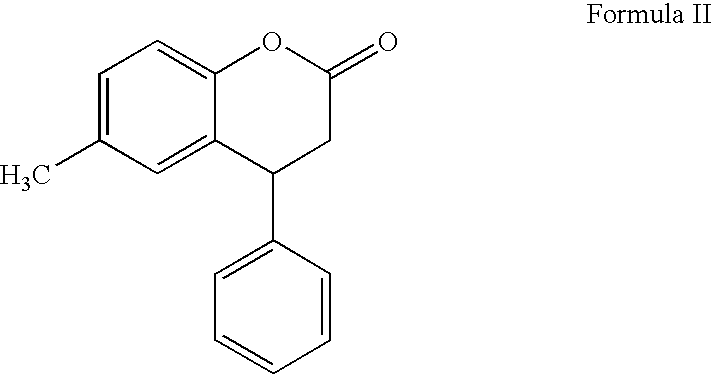Process for preparing tolterodine
a technology of tolterodine and process, which is applied in the field of process for the preparation of tolterodine, can solve the problems of low overall yield, unsuitable and hazardous process on a commercial scale, and high cost of process and less production
- Summary
- Abstract
- Description
- Claims
- Application Information
AI Technical Summary
Benefits of technology
Problems solved by technology
Method used
Image
Examples
example 1
Preparation of METHYL 3-(2-BENZYLOXY-5-METHYLPHENYL)-3-PHENYLPROPIONATE (Formula III)
[0078]675 g of 6-methyl-4 phenyl-3,4-dihydrocoumarin, 372 ml of benzyl bromide, and 513 g of potassium carbonate were charged into a round bottom flask containing a mixture of 2025 ml of acetone and 2025 ml of methanol. The contents were heated to reflux temperature for about 2-3 hours. Distilled off the solvent from the reaction mass at atmospheric conditions below 75° C. then under vacuum (about 600 mm Hg) at below 85° C. 6750 ml of water was added to the residue and stirred for 15 minutes for dissolution. Extracted the solution twice with ethyl acetate (4000 ml). Combined organic layers were washed with water (2×3375 ml) and distilled the solvent under vacuum (about 600 mm Hg) at below 85° C. 2025 ml of methanol was added to the residue at 50-55° C., then stirred the solution at 0-5° C. for about 2 hours. Filtered the formed solid and washed with 675 ml of methanol. Dried the solid at 50-55° C. ...
example 2
Preparation of 3-(2-BENZYLOXY-5-METHYLPHENYL)-3-PHENYLPROPANOL (Formula IV)
[0080]810 g of methyl-3 -(2-benzyloxy-5-methylphenyl)-3 -phenylpropionate and 3240 ml of toluene were stirred at 25-30° C. for about 20 minutes. 842.5 ml of VITRIDE® (sodium bis(2-methoxyethoxy)aluminum hydride, 65% w / w in toluene) was added slowly to the reaction mass below 40° C. under a nitrogen atmosphere, and stirred for about 20-25 minutes. A solution of 1620 ml of concentrated hydrochloric acid and 1620 ml of water was added slowly to the reaction mass and stirred for 15-20 minutes. The aqueous layer was separated and extracted with toluene (810 ml). Combined organic layers were washed with 4050 ml of water and then with 10% aqueous sodium carbonate solution (4050 ml). Organic layer was further washed with water (2×2430 ml) and the solvent was distilled under vacuum (about 600 mm Hg) below 100° C. 3240 ml of hexane was added to the residue at 30-40° C. and stirred for 2-3 hours. It was further cooled t...
example 3
Preparation of N,N-DIISOPROPYL-3-(2-HYDROXY-5-METHYLPHENYL)-3-PHENYLPROPYLAMINE HYDROCHLORIDE (Formula V)
Step A: 3-(2-(BENZYLOXY)-5-METHYLPHENYL)-3-PHENYLPROPYL-4-METHYLBENZENESULFONATE (Formula IVa)
[0082]2010 ml of dichloromethane, 670 g of 3-(2-benzyloxy-5-methylphenyl)-3-phenyl propanol, and 844 ml of triethyl amine were stirred at 25-35° C. for about 10-20 minutes. A solution of p-toluene sulphonyl chloride (462 g) in dichloromethane (1340 ml) was added slowly to the reaction mass and the mixture was stirred at 25-35° C. for about 10-12 hours. A solution of 335 ml of 36% aqueous hydrochloric acid and 3015 ml of water was added to the reaction mass and stirred for 20-25 minutes. Organic layer was separated and washed with water (2×3350 ml). Distilled the solvent from the organic layer under a vacuum of about 600 mm Hg below 45° C., and the residue was dissolved in 4900 ml of acetonitrile.
Step B: N,N-DIISOPROPYLAMINE-3-(2-BENZYLOXY-5-M ETHYLPHENYL)-3-PHENYLPROPYLAMINE (Formula ...
PUM
| Property | Measurement | Unit |
|---|---|---|
| temperature | aaaaa | aaaaa |
| temperature | aaaaa | aaaaa |
| temperatures | aaaaa | aaaaa |
Abstract
Description
Claims
Application Information
 Login to View More
Login to View More - R&D
- Intellectual Property
- Life Sciences
- Materials
- Tech Scout
- Unparalleled Data Quality
- Higher Quality Content
- 60% Fewer Hallucinations
Browse by: Latest US Patents, China's latest patents, Technical Efficacy Thesaurus, Application Domain, Technology Topic, Popular Technical Reports.
© 2025 PatSnap. All rights reserved.Legal|Privacy policy|Modern Slavery Act Transparency Statement|Sitemap|About US| Contact US: help@patsnap.com



